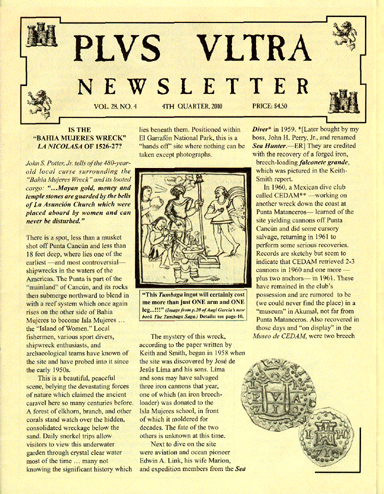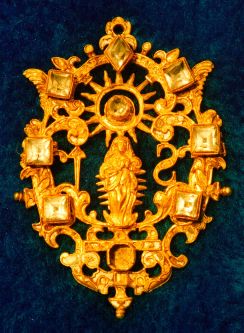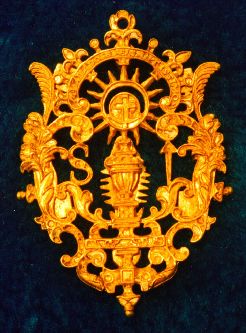| The ships of the New Spain Fleet
numbered 21, counting the two supply ships
going along in convoy to Saint Augustine.
One of the ships, El Africa
of Captain Daniel Huboni, managed to save
itself by deploying two huge storm anchors
in 200 feet of water east of the north Key
Largo reef line. The rest grounded on top
of the reefs and shallows of the Florida
Keys, from north Key Largo to Marathon.
Several were refloated and taken back to
Havana, but the remains of the bulk still
lie here awaiting the persistent treasure
diver.
In 1974, I worked the “Capitana” under
contract with the State of Florida
(S-14-A), with a company called
Peninsular Exploration & Salvage,
Inc., which was operated by Richard
MacAllaster and Rex DeRosay. We worked
the wreck with an ancient 50-foot
fishing boat, equipped with a
mailbox-type dredging device that swung
down over the ship’s lone propeller.
When the ship was tied off with anchors
and placed in gear in twenty feet of
water, the propwash would create a hole
35 feet in diameter and eight feet deep.
We found lots of artifacts with this old
contraption.
We were always accompanied by a State
Agent who catalogued and tagged
everything that was brought up. There
was this one thing I found which will
always stay burned indelibly in my
memory. It was an ivory, hand-carved
combination sundial and magnetic
compass, about three inches tall by one
inch in diameter. This piece, along with
many other “Capitana” artifacts, can
still be seen in the State of Florida’s
shipwreck display in Tallahassee,
Florida.
So when I went out diving that day in
April of 1987 I was visiting a wreck
which was no stranger to me. I worked
around the grass patch for about an
hour, picking up several encrusted
ship’s nails, which I placed in a pile
at the base of the grass patch. My
thoughts went back to one particular day
on the capitana when I
had spotted what looked like a flintlock
pistol, about thirty feet away. It was
lying on the surface, partially
camouflaged by virtue of nature. I
flippered over and placed my detector
loop over it. The resulting loud squeal
confirmed my suspicions; the object was
a 1733 vintage flintlock pistol! It is
amazing what you can find on the bottom
if you know what you’re looking
for.
As I continued to methodically search
the bottom, I was easing away from the
grass patch and now was searching an
area of open sand about fifty feet east
of it. Suddenly my underwater detector
let out a squeal. I laid the detector
down and proceeded to hand-fan away the
sand and coral debris. When I had a hole
about six inches deep I placed the loop
into the depression.
“Squeeeeeal!” This time much
louder.
Knowing I had to be close to the buried
object, I gave a couple of more fast
sweeps with my hand, stirring up a big
cloud of brown sand and rotted grass
debris. When it cleared, a grayish
object appeared in the center of the
hole.
I reached down and carefully felt the
object. It was loose, so I brought it up
out of the hole and examined it
carefully. It appeared to be an iron
lock hasp of sorts, the type which would
have been used to secure someone’s
personal baggage or trunk. I reached
into my wetsuit and dragged out a net
“goodie” bag, carefully placing the hasp
inside. This was a “keeper,” and I
intended to preserve it.
When detecting, there is an unwritten
law: Whenever you find something in a
hole you always check again to see if
anything else is in there. So I placed
the loop down in the hole and it gave
off another squeal.
Carefully, and now with a hint of
excitement since I knew the lock hasp
was a sign of someone’s valuable
baggage, I hand-fanned the hole deeper.
After a couple of minutes I was down to
about twelve inches, exposing large
hunks of coral rubble.
Then I saw it...
The unmistakable color of gold lying on
the bottom, with the mid-day sun
glittering off it. My fingers trembled
as I retrieved the object. Then I lay
there, oblivious to the rest of the
world, looking at the most beautiful
encrusted gold medallion I had ever
seen. Even
though it was heavily coated with dead
coral, I could still make out the jewels
around the central figure of Our Lady of
Guadalupe. I turned it over and realized
the other side was crafted as well. It
was a two-sided medallion, which made it
even more desirable.
Instinctively, I swung the loop over
the hole, hoping for the impossible.
Nothing. The area was clean.
I unbuckled my weight belt, which had a
surface buoy tied to it, dropped it into
the hole and swam my golden prize back
to the boat. I reached over the boat’s
gunwale and carefully placed the
medallion on the seat before scrambling
back aboard. I shucked off the air tank,
kicked off my fins, and sat down on the
seat. Carefully I peered at the golden
Madonna, knowing I was the first person
to do so in over 250 years.
It was even more beautiful on the
surface, and I knew I had found
something of indeterminable worth. It
was the day of all days for me, and the
beginning of a lifelong struggle to try
and top it.
Life has a way of turning sweet or sour
in a heartbeat, so to speak. On 25 April
1987 I found the greatest artifact of my
shipwreck salvage diving career. On 27
April I had to commit my best friend to
eternity. My buddy of ten years through
thick and thin, Henry the Cat, had
terminal cancer, and my last kindness to
him was to have Dr. Foley put him to
sleep. They say this is the ultimate act
of love between an animal and its human
companion. Maybe so, but it was the
hardest damned decision I’ve ever had to
make.
A lot of water has gone under my boat
since that day on the “Capitana,” and I
confess I have yet to recall a day like
it. But a word to the wise for the
aspiring treasure seeker: Persistence!
The secret to finding treasure
isn’t some mystical acumen, possessed
only by a certain select few, it’s a
measure of the time spent on the bottom
picking up a million myriad mediocre
things, punctuated by the one moment of
glory when you find the Holy Grail. =Jack=
NOTE: The “Capitana Medallion”
has been appraised at $200,000 to
$250,000 by three independent agents:
Mendel Peterson, former curator at the
Smithsonian Institute ($250K); Alfred S.
Friedel, GEMINOR, New York ($250K); and
Colin C. Howard, Appraiser, London
($200K). Peterson describes the
artifact, in part:
"Cast and carved gold filigree
medallion, 78 mm x 50 mm. For wear on a
neck chain. Set with nine quartz crystal
stones: 6 square, 1 diamond shape, 1
octagonal, and 1 round brilliant.
Reverse shows a monstrance in Glory with
“S” left and “I” right. Obverse shows
the Virgin of Guadaloupe in Glory.
Weight of the piece is 38.1 dwt. Over
monstrance is a ribbon inscribed (in
translation) “Salvation to the Holiest
One.” Obverse has inscription partially
covered by the jewels."
This story, along with before-and-after
color photos of the medallion, have been
included in Bob “Frogfoot” Weller’s
upcoming book about the 1733 Spanish
Treasure Fleet, Galleon Alley,
due out in mid-2001. —ed.
|



